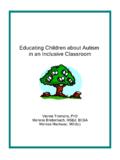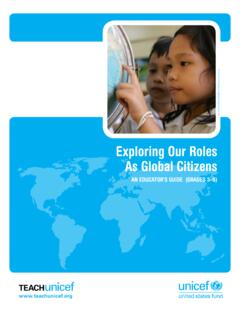Transcription of INTRODUCING THE Teaching Tolerance Anti-bias Framework
1 A PROJECT OF THE SOUTHERN POVERTY LAW THE Teaching Tolerance Anti-bias FrameworkIntroducing the Teaching Tolerance Anti-bias Framework a road map for Anti-bias education at every grade level. The Anti-bias Framework (ABF) is a set of anchor standards and age-appropriate learning outcomes divided into four domains identity, diversity, justice and action (IDJA). The standards provide a common language and organizational structure: Teachers can use them to guide curriculum development, and administrators can use them to make schools more just, equitable and safe.
2 The ABF is leveled for every stage of K-12 education and includes school-based scenarios to show what Anti-bias attitudes and behavior may look like in the classroom. Teaching about IDJA allows educators to engage a range of Anti-bias , multicultural and social justice issues. This continuum of engagement is unique among social justice Teaching materials, which tend to focus on one of two areas: either reducing prejudice or advocating collective action. Prejudice reduction seeks to minimize conflict and generally focuses on changing the attitudes and behaviors of a dominant group.
3 Collective action challenges inequality directly by raising consciousness and focusing on improving conditions for under-represented groups. The ABF recognizes that, in today s diverse classrooms, students need knowledge and skills related to both prejudice reduction and collective action. The IDJA domains are based on Louise Derman-Sparks four goals for Anti-bias education in early childhood. The Teaching Tolerance Anti-bias Framework was prepared under the guidance of Teaching Tolerance Director Maureen Costello. The principle writer was Emily Chiariello, with Julie Olsen Edwards, Thom Ronk, Sara Wicht and Natalie Owen contributing.
4 Sixteen educators on the 2012 Teaching Tolerance Advisory Board provided feedback. The Framework was edited by Alice Pettway and designed by Sunny Paulk. The Anti-bias Framework was developed to support the Perspectives for a Diverse America K-12 curriculum. For more information about Perspectives, visit 2014 Teaching Tolerance // may be reproduced for educational purposesTEACHING Tolerance Anti-bias FRAMEWORKA nchor Standards and Domains 1. Students will develop positive social identities based on their membership in multiple groups in Students will develop language and historical and cultural knowledge that affirm and accurately describe their membership in multiple identity Students will recognize that peoples multiple identities interact and create unique and complex Students will express pride, confidence and healthy self-esteem without denying the value and dignity of other Students will recognize traits of the dominant culture.
5 Their home culture and other cultures and understand how they negotiate their own identity in multiple spaces. 6. Students will express comfort with people who are both similar to and different from them and engage respectfully with all Students will develop language and knowledge to accurately and respectfully describe how people (including themselves) are both similar to and different from each other and others in their identity Students will respectfully express curiosity about the history and lived experiences of others and will exchange ideas and beliefs in an open-minded Students will respond to diversity by building empathy , respect , understanding and Students will examine diversity in social, cultural.
6 Political and historical contexts rather than in ways that are superficial or Students will recognize stereotypes and relate to people as individuals rather than representatives of Students will recognize unfairness on the individual level ( , biased speech) and injustice at the institutional or systemic level ( , discrimination).13. Students will analyze the harmful impact of bias and injustice on the world, historically and Students will recognize that power and privilege influence relationships on interpersonal, intergroup and institutional levels and consider how they have been affected by those Students will identify figures, groups, events and a variety of strategies and philosophies relevant to the history of social justice around the world.
7 16. Students will express empathy when people are excluded or mistreated because of their identities and concern when they themselves experience Students will recognize their own responsibility to stand up to exclusion, prejudice and Students will speak up with courage and respect when they or someone else has been hurt or wronged by Students will make principled decisions about when and how to take a stand against bias and injustice in their everyday lives and will do so despite negative peer or group Students will plan and carry out collective action against bias and injustice in the world and will evaluate what strategies are most effective.
8 IDENTITY DIVERSITYJUSTICEACTION2 Teaching Tolerance ANTI BIAS FRAMEWORKK-2 Grade Level Outcomes and ScenariosAnchor StandardCode Grade Level OutcomeAnti-bias ScenarioIdentity 1 know and like who I am and can talk about my family and myself and name some of my group show and tell, Joi brings in a picture of her family on a church camping trip. My family goes camping a lot. I like camping, she says. I m a Christian, and sometimes my family goes camping with the church. I m also a big sister, so I have to help my parents take care of my little brother, especially when we go camping.
9 Identity can talk about interesting and healthy ways that some people who share my group identities live their know that all my group identities are part of me but that I am always ALL me. Identity can feel good about myself without being mean or making other people feel bad. Identity see that the way my family and I do things is both the same as and different from how other people do things, and I am interested in both. Diversity like being around people who are like me and different from me, and I can be friendly to everyone.
10 As children are funneling into her classroom on a Monday morning, Ms. Franklin overhears a conversation between two students. Diversity can describe some ways that I am sim-ilar to and different from people who share my identities and those who have other identities. What did you do last weekend? Kev-in asks Lisa. My moms took me to the zoo! Lisa replies. Diversity want to know about other people and how our lives and experiences are the same and different. You have two moms? Do you call both of them Mom? I call them Mamma Kendra and Mamma Sam, Lisa know everyone has feelings, and I want to get along with people who are similar to and different from me.










